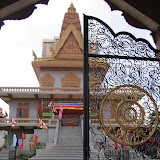 |
| Phnom Penh, Cambodia |
A few more hours on the bus after the border crossing, and we arrived in Phnom Penh. The architecture and layout were not all that different from what I had witnessed in Vietnam. However, the economic and social disparities between the two countries quickly became apparent. As the bus rolled through the downtown streets, piles of garbage cluttered the sidewalks, the roads were in disrepair and the city had a generally depressed air about it. After leaving the bus and running through the now customary gauntlet of taxi and "tuk-tuk" (multipassenger motorcycle taxis) touts, we got to our hotel and settled in.
Only having planned for a couple of days in Phnom Penh, we got straight to work on taking in the sights and getting a taste of Cambodian culture. We decided our first stop should be to one of the well known attractions in the area, the "Killing Fields" that were the site of brutal massacres by the Khmer Rouge between 1975 and1979. [The Khmer Rouge were a Marxist regime, led by the infamous Pol Pot, that killed 1-2 million people (about 20-30% of the population) in a genocide with an end goal of "social engineering". In order to set up their ideal society based on agrarian communes, the Khmer Rouge tortured and massacred anyone suspected of promoting education, progress, religion or any foreign ideas, including foreigners, intellectuals, religious figures and teachers.]
We asked a tuk-tuk driver if he could take us there since it was a few miles out of town, and he said that he already had a couple going there, but we may be able to share the ride. The other couple, Andre and Melissa, happened to be Americans as well, and turned into good friends for the remainder of our time in the city. The four of us shared a ride out the the site, and as we drove down the dirt road leading down to the Killing Fields, we had no idea what we were in for.
A sign of things to come was the focal point in the center of the site: A seven-story pagoda reaching to the sky, each floor filled completely with only one thing... human skulls. As we walked around the grounds, which were relatively nondescript, the mood did not get any more uplifting. The terrain looked like any regular field, except that it was pocketed with large depressions everywhere, ranging in diameter from 7-20 feet. The signs placed intermittently throughout the field provided a grim education; the pits were used to bury those killed in the bloody genocide orchestrated by Pol Pot and the Khmer Rouge. Everywhere we looked, there were more mass graves, and as the sky turned gray with clouds, it was not hard to imagine the horrors that took place right where you were standing, perhaps not more than 30 years ago. Soon, the sky broke out into a violent thunderstorm, and Ian, Andre, Melissa and I took shelter in a small gazebo. There, we all reflected on the pervasive mood of death and despair that hung over the whole place. Even though we had not really said a word to each other since arriving, we all shared the same depressed and solemn disposition. We huddled under the roof, watching the sheets of rain continue for another twenty minutes, before we finally decided to make a break for the tuk tuk and have a change of scenery. We finally made it back, our mood lightened up a bit from racing back through the pouring rain.
Our next destination, however, would do very little to brighten our day. The four of us, now soaking wet, proceeded to visit Tuol Sleng, a.k.a. S-21, which was a prison used by the Khmer Rouge to hold their victims before murdering them. From the outside, the former high school seemed innocuous enough. But, as I wandered through the dark, dank hallways, and passed the rooms that had been converted to jail cells and torture chambers, I was soon overwhelmed by a sense of despair and darkness. A room filled with black and white photos of the victims, some in large format, gave faces to the haunted souls that permeated the air as you toured the building. I wandered off on my own, reflecting on the personal stories that were told on the faces in the photos, and stopped as I got into a dark, silent room, that had been divided into tiny cells for prisoners. There, with the rain still drenching the ground outside, and small creaks and unidentifiable sounds breaking the weighty silence, I felt that I occupied a space more haunted than anywhere I'd ever been. You could sense the pain and despair seeping in from every corner, and you can almost feel the restless souls brush by you as you stand there, transfixed by an iron chain that was once attached to the leg of a victim.
The rain continued through the rest of the day, as did the depressed mood of our group of four. We all were deeply affected by the sights we had taken in, and wrapped up the day reflecting on our grim introduction to Phnom Penh.
(For more background on the Khmer Rouge, this BBC article is a good quick summary)




No comments:
Post a Comment